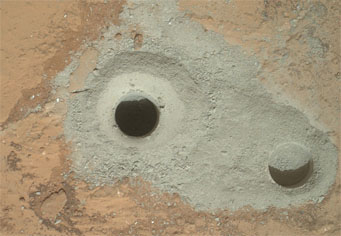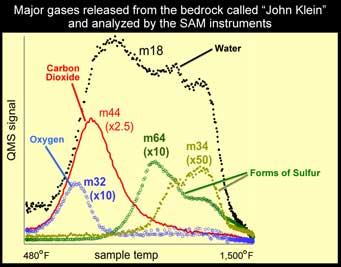The results from the Curiosity rover's first rock-drilling are in.

At center left is the first full-depth hole drilled on Mars by Curiosity. About 0.6 inch wide and 2.5 inches deep, it was made in a sedimentary rock called "John Klein". At right is a shallower hole created during a test of the drill two days earlier. Click here for a more detailed view.
NASA / JPL
In the list of firsts for the NASA Curiosity rover’s mission, the last one on the list — the results from its first rock-drilling — are a major find: the revelation of what could be a former habitable environment on Mars.
Scientists announced today at a NASA press conference their analysis of bits of the rock John Klein, a sedimentary rock that Curiosity drilled into in February. By weight the rock is 20–30% smectite, a group of clay-like minerals that forms in the presence of water. The presence of calcium sulfates indicates the water probably had a relatively neutral pH, and the water also wasn't too salty. All told, the results suggest that this region of Gale Crater, called Yellowknife Bay, was once some sort of lake bed.
“We found a habitable environment that is so benign and supportive of life, that probably if this water was around and you had been on the planet, you would have been able to drink it,” said project scientist John Grotzinger (Caltech).
How large, deep, or long-lived this lake bed was, the scientists can’t say. They also can’t give a good estimate of when it existed, although the ballpark estimate is 3 billion years. That’s roughly around the time when life first arose on Earth, but take that with a grain of salt because the exact age at which Earth’s life appeared is debated.

An analysis of a drilled rock sample from NASA’s Curiosity rover shows the presence of water, carbon dioxide, oxygen, sulfur dioxide, and hydrogen sulfide released on heating. The results analyzing the high temperature water release are consistent with smectite clay minerals. Click here to zoom and for more information.
NASA GSFC / JPL-Caltech
What’s whetted scientists’ appetite (pun intended) is the hint of carbon and organic compounds. The carbon dioxide detected by the Sample Analysis at Mars (SAM) experiment could have been created from residual terrestrial carbon that contaminated the instruments — this is the first time the drill’s been used, so it’s too soon to say whether the compounds are natural to Mars, cautioned SAM principal investigator Paul Mahaffy (NASA Goddard). Two potential methane compounds also need confirmation.
Carbon would be exciting because microbes could use it in their metabolism. Other elements identified by SAM include oxygen, hydrogen, sulfur, and phosphorus. What’s also exciting is that the rock contains chemicals in both oxidized and non-oxidized forms — if you look at the rock post-drilling, the part revealed by the drill is gray, meaning it’s less oxidized that the reddish surface. This combination of oxidized and reduced chemicals could create an “energy gradient,” a chemical battery that could power primitive microorganisms.
None of these results means that microbes actually existed on Mars. But the Yellowknife Bay area is the first on Mars to show definite signs of past habitability.
The Curiosity team plans to drill again to confirm the results. But that will have to wait until May: technical problems required a rover reboot, delaying science operations, and solar conjunction is almost upon us, meaning Mars will be behind the Sun from our position and no communication with the rover will be possible.
The results don’t directly bear on the origin of Aeolis Mons, commonly called Mount Sharp. At the American Geophysical Union meeting last December, researchers using Mars Reconnaissance Orbiter images suggested that Mount Sharp might actually be a pile of dust scoured out by carefully directed winds, and not a sedimentary pileup as planetary scientists hoped. The jury’s still out on that, but as Curiosity finishes up at John Klein and heads for Mount Sharp it will continue taking samples to check how the rocks' compositions change on approach. It could be that Yellowknife Bay is part of Mount Sharp’s base, meaning the mound is indeed sedimentary, Grotzinger said — but only time will tell.
 2
2
Comments
Anthony Barreiro
March 14, 2013 at 1:04 pm
This is very exciting news. I'm trying to remember my high school and college chemistry!
How long will Mars be out of communication? What do the Martian rovers and orbiters do when Mars is on the other side of the Sun from Earth? Are they turned off until direct communication can be reestablished, or are they programmed with tasks to fill the intervening time?
You must be logged in to post a comment.
Anthony Barreiro
March 14, 2013 at 1:04 pm
This is very exciting news. I'm trying to remember my high school and college chemistry!
How long will Mars be out of communication? What do the Martian rovers and orbiters do when Mars is on the other side of the Sun from Earth? Are they turned off until direct communication can be reestablished, or are they programmed with tasks to fill the intervening time?
You must be logged in to post a comment.
You must be logged in to post a comment.